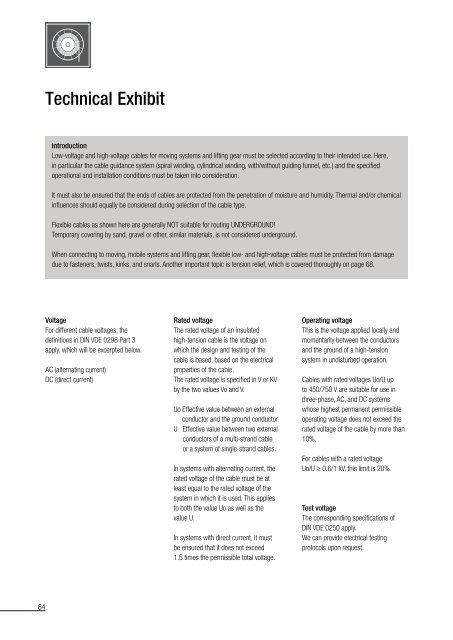Conductix-Wampfler Cables for Reeling Systems
Conductix-Wampfler Cables for Reeling Systems
Conductix-Wampfler Cables for Reeling Systems
Create successful ePaper yourself
Turn your PDF publications into a flip-book with our unique Google optimized e-Paper software.
64<br />
Technical Exhibit<br />
Introduction<br />
Low-voltage and high-voltage cables <strong>for</strong> moving systems and lifting gear must be selected according to their intended use. Here,<br />
in particular the cable guidance system (spiral winding, cylindrical winding, with/without guiding funnel, etc.) and the specified<br />
operational and installation conditions must be taken into consideration.<br />
It must also be ensured that the ends of cables are protected from the penetration of moisture and humidity. Thermal and/or chemical<br />
influences should equally be considered during selection of the cable type.<br />
Flexible cables as shown here are generally NOT suitable <strong>for</strong> routing UNDERGROUND!<br />
Temporary covering by sand, gravel or other, similar materials, is not considered underground.<br />
When connecting to moving, mobile systems and lifting gear, flexible low- and high-voltage cables must be protected from damage<br />
due to fasteners, twists, kinks, and snarls. Another important topic is tension relief, which is covered thoroughly on page 68.<br />
Voltage<br />
For different cable voltages, the<br />
definitions in DIN VDE 0298 Part 3<br />
apply, which will be excerpted below.<br />
AC (alternating current)<br />
DC (direct current)<br />
Rated voltage<br />
The rated voltage of an insulated<br />
high-tension cable is the voltage on<br />
which the design and testing of the<br />
cable is based, based on the electrical<br />
properties of the cable.<br />
The rated voltage is specified in V or KV<br />
by the two values Vo and V.<br />
Uo Effective value between an external<br />
conductor and the ground conductor<br />
U Effective value between two external<br />
conductors of a multi-strand cable<br />
or a system of single-strand cables.<br />
In systems with alternating current, the<br />
rated voltage of the cable must be at<br />
least equal to the rated voltage of the<br />
system in which it is used. This applies<br />
to both the value Uo as well as the<br />
value U.<br />
In systems with direct current, it must<br />
be ensured that it does not exceed<br />
1.5 times the permissible total voltage.<br />
Operating voltage<br />
This is the voltage applied locally and<br />
momentarily between the conductors<br />
and the ground of a high-tension<br />
system in undisturbed operation.<br />
<strong>Cables</strong> with rated voltages Uo/U up<br />
to 450/750 V are suitable <strong>for</strong> use in<br />
three-phase, AC, and DC systems<br />
whose highest permanent permissible<br />
operating voltage does not exceed the<br />
rated voltage of the cable by more than<br />
10%.<br />
For cables with a rated voltage<br />
Uo/U ≥ 0.6/1 kV, this limit is 20%.<br />
Test voltage<br />
The corresponding specifications of<br />
DIN VDE 0250 apply.<br />
We can provide electrical testing<br />
protocols upon request.


